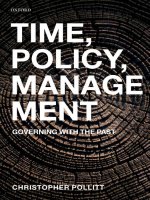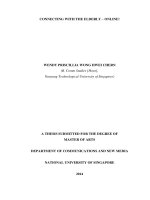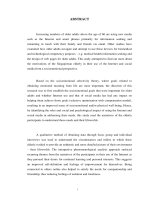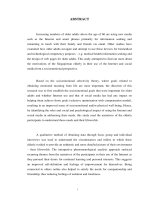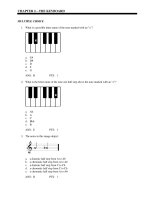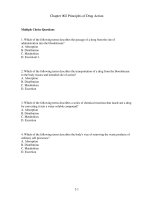American history connecting with the past 15th edition alan brinkley test bank
Bạn đang xem bản rút gọn của tài liệu. Xem và tải ngay bản đầy đủ của tài liệu tại đây (186.65 KB, 24 trang )
Chapter 2
Transplantations and Borderlands
Multiple-Choice Questions
1. Seventeenth-century English colonial settlements
A. were mostly business enterprises.
B. were tightly controlled by the English government.
C. were effectively isolated from contact with other nations.
D. were well-planned and generally quite successful from the start.
E. maintained the political and social institutions of England.
Answer: A
Page: 35
Topic: The Early Chesapeake
2. Which of the following does NOT describe the site chosen for the Jamestown settlement?
A. It was low and swampy and subject to outbreaks of malaria.
B. It was inland so as to offer security from natives.
C. It bordered the territories of powerful Indian tribes.
D. It was surrounded by thick woods.
E. It was inaccessible by ship.
Answer: E
Page: 35
Topic: The Early Chesapeake
3. The initial Jamestown colonists focused primarily on
A. the long-term success of the settlement.
B. building a family-centered community.
C. developing peaceful relations with the Indians in the area.
D. the search for gold.
E. converting the local Indians to Christianity.
Answer: D
Page: 35
Topic: The Early Chesapeake
4. Captain John Smith helped the Jamestown settlement survive by
A. waging all-out war with the local Indians.
B. dividing decision-making authority among the colonists to improve morale.
C. imposing work and order on the colonists.
D. introducing tobacco to the colonists.
E. importing African slaves to rebuild the fort.
Answer: C
Page: 36
Topic: The Early Chesapeake
Copyright © 2015 McGraw-Hill Education. All rights reserved.
No reproduction or distribution without the prior written consent of McGraw-Hill Education.
5. The “starving time” in Jamestown during the winter of 1609–1610 was partly the result of
A. major fires that ravaged surrounding crop lands.
B. the extermination of the Indians who used to grow crops.
C. an influx of rats from settlers’ ships that ate much of the stored grains.
D. a drought that led to crop failures.
E. the sinking of the colonists’ supply ship in the Atlantic.
Answer: A
Page: 36
Topic: The Early Chesapeake
6. The first profitable economic development in Jamestown resulted from
A. the discovery of gold and silver.
B. fur trade with the Indians.
C. the production of tobacco.
D. development of fisheries and lumber.
E. the cultivation of cotton.
Answer: C
Page: 36
Topic: The Early Chesapeake
7. The cultivation of tobacco around Jamestown resulted in all the following EXCEPT
A. the rapid wearing out of the soil.
B. the search for new sources of labor.
C. rising prosperity for the colony.
D. improved relations with the local Indians.
E. the expansion of European settlement into the interior.
Answer: D
Page: 37-38
Topic: The Early Chesapeake
8. The Virginia Company developed the “headright” system to
A. attract new settlers to the colony.
B. discourage poor people from moving to the colony.
C. require families to migrate together.
D. raise revenue from the sale of land.
E. cause conflict among the neighboring Indian tribes.
Answer: A
Page: 38
Topic: The Early Chesapeake
Copyright © 2015 McGraw-Hill Education. All rights reserved.
No reproduction or distribution without the prior written consent of McGraw-Hill Education.
9. Which of the following statements best characterizes the first years of Jamestown’s
existence?
A. A majority of its colonists enjoyed significant economic success.
B. The settlement was often assaulted by Spanish invaders.
C. The settlement was notable for its peaceful relations with local Indians.
D. The settlement was notable for its toleration of political freedom.
E. The settlement survived despite an enormous loss of life.
Answer: E
Page: 36
Topic: The Early Chesapeake
10. When the House of Burgesses was created in Virginia in 1619,
A. it gave settlers full political control of their colony.
B. landowning women colonists were allowed to vote.
C. colonists were given a share of local political representation.
D. it put an end to a violent uprising by disgruntled colonists.
E. it recommended that Virginia declare independence from England.
Answer: C
Page: 38
Topic: The Early Chesapeake
11. The first blacks imported to Virginia in 1619
A. may have been considered indentured servants by the colonists.
B. sparked an immediate rapid stream of African slaves to the British colonies.
C. were preferred to European indentured servants.
D. followed Indians into slavery.
E. arrived as independent landowners.
Answer: A
Page: 38
Topic: The Early Chesapeake
12. The Powhatan Indian Pocahontas
A. married Englishman John Smith.
B. was kidnapped by John Rolfe.
C. created an interest in England in “civilizing” Indians.
D. was the cause of a war between the Powhatan Indians and Virginian colonists.
E. refused to convert to Christianity.
Answer: C
Page: 38
Topic: The Early Chesapeake
Copyright © 2015 McGraw-Hill Education. All rights reserved.
No reproduction or distribution without the prior written consent of McGraw-Hill Education.
13. Warfare between Englishmen and Powhatan Indians in Virginia
A. continued without interruption until the early eighteenth century.
B. was first triggered by the kidnapping of Pocahontas.
C. was primarily a result of religious tensions between natives and settlers.
D. was uncommon until the early eighteenth century.
E. included an Indian attack on Jamestown that killed hundreds of colonists.
Answer: E
Page: 38
Topic: The Early Chesapeake
14. The Virginia Company
A. never sanctioned military action against the Native Americans of Virginia.
B. deeply opposed the importation of Africans to the colonies.
C. was absorbed by the crown because it was becoming too powerful.
D. had its charter revoked by James I.
E. found most of its Virginia ventures to be very profitable.
Answer: D
Page: 38
Topic: The Early Chesapeake
15. In which area of technology were Indians more advanced than the Virginia colonists?
A. agriculture
B. ocean-going vessels
C. weaponry
D. tools
E. animal husbandry
Answer: A
Page: 39
Topic: The Early Chesapeake
16. In the seventeenth century, English colonists recognized that corn
A. could only be grown in the New World.
B. was their most financially valuable crop.
C. produced yields greater than any of the European grains.
D. was a particularly difficult crop to cultivate.
E. could not be grown in the swampy land around Jamestown.
Answer: C
Page: 39
Topic: The Early Chesapeake
Copyright © 2015 McGraw-Hill Education. All rights reserved.
No reproduction or distribution without the prior written consent of McGraw-Hill Education.
17. In its beginning, the Maryland colony
A. experienced tremendous warfare with local Indians.
B. allowed no Protestant settlers.
C. was a refuge for English Catholics.
D. was led by Captain John Smith.
E. experienced considerable conflict with nearby French settlers.
Answer: C
Page: 39
Topic: The Early Chesapeake
18. Which the following statements regarding Sir William Berkeley is FALSE?
A. He was a dominant political figure in Virginia for more than three decades.
B. He encouraged Virginia to develop westward.
C. His relations with Indians were violent and bloody.
D. He extended political representation for frontier settlers.
E. He sent explorers across the Blue Ridge Mountains.
Answer: D
Page: 40
Topic: The Early Chesapeake
19. By 1670, political representation for colonists in Virginia
A. saw elections take place every two years.
B. was open to all white men over the age of twenty-one.
C. had grown more restrictive.
D. favored western counties over eastern counties.
E. expanded to include landholding black men.
Answer: C
Page: 40
Topic: The Early Chesapeake
20. Bacon’s Rebellion
A. spelled the demise of the Virginia Company.
B. saw the royal governor of Virginia forced to resign.
C. spread throughout several colonies.
D. carried on for several years.
E. was a conflict between eastern and western political forces in Virginia.
Answer: E
Page: 41
Topic: The Early Chesapeake
Copyright © 2015 McGraw-Hill Education. All rights reserved.
No reproduction or distribution without the prior written consent of McGraw-Hill Education.
21. The suppression of Bacon’s Rebellion helped spur
A. tobacco production.
B. slavery in Virginia.
C. European investment.
D. the triangular trade.
E. calls for independence from England.
Answer: B
Page: 41
Topic: The Early Chesapeake
22. In 1608, Puritan Separatists that left England
A. sought refuge in Virginia.
B. emigrated quietly to northern France.
C. were encouraged by the Church of England to emigrate.
D. chartered a colony in Plymouth.
E. could not legally do so without the king’s permission.
Answer: E
Page: 41
Topic: The Growth of New England
23. In 1620, the Puritan Pilgrims who came to North America
A. intended to settle at Cape Cod.
B. came over the objections of the Virginia colony.
C. were seeking to escape military service in England.
D. hoped to create their ideal close-knit Christian community.
E. enjoyed a particularly mild winter their first year.
Answer: D
Page: 41
Topic: The Growth of New England
24. During the early years the survival and growth of the Plymouth colony
A. was due in large part to the assistance of the natives.
B. led the colonists to grow rich from the surrounding productive farmlands.
C. saw the colonists carry out warfare that wiped out much of the local Indian population.
D. nevertheless saw two-thirds of its population die.
E. was critically important for trade routes with Jamestown to the south.
Answer: A
Page: 42
Topic: The Growth of New England
Copyright © 2015 McGraw-Hill Education. All rights reserved.
No reproduction or distribution without the prior written consent of McGraw-Hill Education.
25. King Charles I’s treatment of Puritans could be characterized as
A. relatively tolerant.
B. extremely hostile.
C. governed by economic motives.
D. more likely to advance Puritan thought in England.
E. unlikely to involve imprisonment for religious beliefs.
Answer: B
Page: 43
Topic: The Growth of New England
26. The Puritan merchants who founded the Massachusetts Bay colony
A. established their capital in Salem.
B. took over what had been a royal colony.
C. were led by Miles Standish.
D. were given their colonial charter by Charles II.
E. carried out the largest single migration in the seventeenth century.
Answer: E
Page: 43
Topic: The Growth of New England
27. The Massachusetts Bay Puritans
A. lived as grim and joyless people.
B. took vows of poverty as evidence of their commitment to their faith.
C. created a colonial “theocracy.”
D. fought with the surrounding Indians almost immediately.
E. introduced freedom of worship to the New World.
Answer: C
Page: 44
Topic: The Growth of New England
28. The Puritan founders in Massachusetts who described their colony as a “city upon a hill”
A. felt they were creating a holy community that would be a model for the world.
B. wanted to construct their community on high ground to save it from Indian attacks.
C. wanted to create a community that would be open to all peoples of all faiths.
D. sought to create a community in which all people were treated as equals.
E. wanted to differentiate their community from the materialism and acquisitiveness of New
Haven.
Answer: A
Page: 44
Topic: The Growth of New England
Copyright © 2015 McGraw-Hill Education. All rights reserved.
No reproduction or distribution without the prior written consent of McGraw-Hill Education.
29. Thomas Hooker is associated with establishing the colony of
A. Rhode Island.
B. Vermont.
C. New Hampshire.
D. Connecticut.
E. Maine.
Answer: D
Page: 45
Topic: The Growth of New England
30. One reason Roger Williams was deported from the Massachusetts colony was that he
A. was a confirmed Separatist.
B. argued that the colony should maintain allegiance to the Church of England.
C. said the land occupied by the colonists belonged to the Indians.
D. attempted to take over the leadership of the colony.
E. advocated the principle of plural marriage.
Answer: A
Page: 45
Topic: The Growth of New England
31. When it was established in 1644, the colony of Rhode Island
A. had strong ties to the church in the Massachusetts colony.
B. organized the first fully democratic government in North America.
C. had no ties to the Massachusetts colony.
D. was notable for its religious toleration.
E. banned Jews from immigrating.
Answer: D
Page: 45
Topic: The Growth of New England
32. In 1638, Anne Hutchinson was deported from the Massachusetts colony because she
A. was accused of practicing witchcraft.
B. argued that only the “elect” were entitled to any religious or political authority.
C. challenged the prevailing assumptions of the proper role of women in society.
D. was a single mother who refused to marry.
E. preached against what she called the “Antinomian heresy.”
Answer: C
Page: 45
Topic: The Growth of New England
Copyright © 2015 McGraw-Hill Education. All rights reserved.
No reproduction or distribution without the prior written consent of McGraw-Hill Education.
33. Which New England Puritan could LEAST accurately be described as a religious dissenter?
A. Anne Hutchinson
B. John Winthrop
C. Roger Williams
D. John Wheelwright
E. Thomas Hooker
Answer: B
Page: 43
Topic: The Growth of New England
34. Over time in the seventeenth century, an increasing number of New England Puritans came
to view Indian society
A. with condescending admiration.
B. with fear and contempt.
C. as worth preserving.
D. as part of the godly community.
E. as helpful neighbors and partners in commerce.
Answer: B
Page: 46
Topic: The Growth of New England
35. In 1637, hostilities broke out between English settlers in the Connecticut Valley and which
local Native American tribe?
A. the Seminoles
B. the Powhatans
C. the Sioux
D. the Wampanoags
E. the Pequots
Answer: E
Page: 46
Topic: The Growth of New England
36. In King Philip’s War, Indians made effective use of a relatively new weapon, the
A. flintlock rifle.
B. matchlock rifle.
C. repeating revolver.
D. Gatling gun.
E. artillery cannon.
Answer: A
Page: 48
Topic: The Growth of New England
Copyright © 2015 McGraw-Hill Education. All rights reserved.
No reproduction or distribution without the prior written consent of McGraw-Hill Education.
37. In the 1640s, during the English Civil War, the Cavaliers were
A. the forces of Parliament, who were largely Puritans.
B. supporters of King Charles I.
C. Scottish and Irish gentry desiring to secede from England.
D. both the forces of Parliament and supporters of King Charles I.
E. neither the forces of Parliament nor supporters of King Charles I.
Answer: B
Page: 49
Topic: The Restoration Colonies
38. The English Restoration began with the reign of
A. James II.
B. Oliver Cromwell.
C. George I.
D. Elizabeth I.
E. Charles II.
Answer: E
Page: 49
Topic: The Restoration Colonies
39. The proprietors who founded the Carolina colony
A. guaranteed religious freedom to all Christians.
B. rejected the headright system.
C. ruled the colony with dictatorial powers.
D. quickly made it a financial success.
E. banned the importation of indentured servants.
Answer: A
Page: 49
Topic: The Restoration Colonies
40. The Fundamental Constitution for the Carolina colony
A. sought to create a society of general equality among Englishmen.
B. was influenced by the English philosopher John Locke.
C. initially did not include slavery.
D. made no provisions for a colonial parliament.
E. All these answers are correct.
Answer: B
Page: 50
Topic: The Restoration Colonies
Copyright © 2015 McGraw-Hill Education. All rights reserved.
No reproduction or distribution without the prior written consent of McGraw-Hill Education.
41. The development of the Carolina colony was notable in that
A. the colony was able to attract large numbers of settlers from nearby colonies.
B. the northern and southern regions were economically and socially distinct from each other.
C. its economy was grounded in tobacco production.
D. its founders had discouraged the use of slaves.
E. it advocated independence from England well before any other mainland colony.
Answer: B
Page: 50
Topic: The Restoration Colonies
42. The New York colony
A. had its founding proprietors from the Carolina colony.
B. made a commitment to representative assemblies.
C. emerged after a struggle between the English and the Dutch.
D. saw its population grow slowly for its first fifty years.
F. banned slavery from its inception.
Answer: C
Page: 51
Topic: The Restoration Colonies
43. Like New York, the New Jersey colony
A. quickly developed a strong local government.
B. had few slaves during its early existence.
C. was characterized by a unified and generally peaceful society.
D. had great ethnic and religious diversity.
E. developed an important class of large landowners.
Answer: D
Page: 52
Topic: The Restoration Colonies
44. Which of the following was NOT a Stuart Restoration colony?
A. Maryland
B. Carolina
C. New York
D. Pennsylvania
E. New Jersey
Answer: A
Page: 49
Topic: The Restoration Colonies
Copyright © 2015 McGraw-Hill Education. All rights reserved.
No reproduction or distribution without the prior written consent of McGraw-Hill Education.
45. Unlike Puritans, the Quakers
A. accepted the concept of predestination.
B. rejected the doctrine of original sin.
C. were not persecuted by the English government.
D. paid their clergy handsomely.
E. All these answers are correct.
Answer: B
Page: 52
Topic: The Restoration Colonies
46. In the seventeenth century, English Quakers
A. granted women a position within the church generally equal to that of men.
B. had no paid clergy.
C. were pacifists.
D. believed all could attain salvation.
E. All these answers are correct.
Answer: E
Page: 52-53
Topic: The Restoration Colonies
47. William Penn
A. was a man of great wealth who converted to Quakerism.
B. established a moderately successful but never cosmopolitan colony.
C. suppressed the local Indians in Pennsylvania with a strong military presence.
D. never visited Pennsylvania.
F. used unscrupulous and deceptive advertising to attract settlers.
Answer: A
Page: 53
Topic: The Restoration Colonies
48. The colony established by people seeking to separate from Pennsylvania was
A. Maryland.
B. New Jersey.
C. Delaware.
D. New York.
E. Kentucky.
Answer: C
Page: 53
Topic: The Restoration Colonies
Copyright © 2015 McGraw-Hill Education. All rights reserved.
No reproduction or distribution without the prior written consent of McGraw-Hill Education.
49. The English colonial settlements in the Caribbean
A. concluded it was cheaper to buy new African slaves than to protect those they owned.
B. developed their settlements along the same lines as those of the Chesapeake.
C. developed significant economic success through the production of tobacco.
D. had a smaller percentage of slaves than that held by the North American colonies.
E. were forced to deal with larger native populations than settlements on the mainland.
Answer: A
Page: 56
Topic: Borderlands and Middle Grounds
50. Which of the following was NOT an agricultural technique used for improving the soil?
A. burning
B. planting beans
C. planting tobacco
D. planting corn and beans together
E. All these answers are correct.
Answer: C
Page: 35, 38, 46
Topic: The Early Chesapeake
51. What became the dominant crop of the Caribbean colonies?
A. corn
B. beans
C. tobacco
D. sugar
E. cotton
Answer: D
Page: 54
Topic: Borderlands and Middle Grounds
52. The Spanish colony of New Mexico
A. was never able to quell the ongoing Pueblo revolt.
B. added no economic value to the Spanish Empire.
C. could be considered prosperous only when compared to other borderlands.
D. contained more than one million Spanish citizens.
E. included the largest Spanish city in the Americas.
Answer: C
Page: 56
Topic: Borderlands and Middle Grounds
Copyright © 2015 McGraw-Hill Education. All rights reserved.
No reproduction or distribution without the prior written consent of McGraw-Hill Education.
53. Georgia was founded
A. to provide a refuge for Catholics.
B. to create a military barrier against the Spanish.
C. to quickly make money for its investors.
D. by Quaker missionaries.
E. as a haven for religious dissenters.
Answer: B
Page: 57
Topic: Borderlands and Middle Grounds
54. Originally, the Georgia colony excluded
A. free Africans.
B. slaves.
C. indentured servants.
D. both free Africans and slaves.
E. neither free Africans nor slaves.
Answer: D
Page: 59
Topic: Borderlands and Middle Grounds
55. In colonial North America, the “middle grounds” refers to a region in which
A. no one European or Indian group held a clear dominance.
B. Indian tribes were largely able to keep European colonists out.
C. English colonists quickly became the dominant power.
D. Spanish colonists were long the dominant power.
E. French colonists managed to hold the balance of power.
Answer: A
Page: 60
Topic: Borderlands and Middle Grounds
56. Which of the following statements regarding the Navigation Acts (1660s) is FALSE?
A. English colonies were closed to all trade except that carried by English ships.
B. Certain colonial products could be exported only to England.
C. All European goods sent to the colonies had to pass through England and were subject to
taxes.
D. English colonists could only produce products that were also sold in England.
E. Duties were imposed on the coastal trade among the English colonies.
Answer: D
Page: 61
Topic: The British Empire in the Mid-Seventeenth Century
Copyright © 2015 McGraw-Hill Education. All rights reserved.
No reproduction or distribution without the prior written consent of McGraw-Hill Education.
57. The Navigation Acts enacted by the English Parliament
A. strangled many colonial American tobacco plantations.
B. encouraged the colonists to create an important shipbuilding industry of their own.
C. damaged the business of New England merchants in favor of English merchants.
D. were passed only through the vigorous political support of Virginian planters.
E. sought to strengthen the British relationship with the Dutch.
Answer: B
Page: 62
Topic: The British Empire in the Mid-Seventeenth Century
58. The Dominion of New England
A. preserved existing colonial legislative assemblies.
B. was called into being by King Charles II.
C. was limited to what now constitutes New England.
D. declared the Navigation Acts null and void.
E. called for a single royal governor.
Answer: E
Page: 62
Topic: The British Empire in the Mid-Seventeenth Century
59. The rebellion led by Jacob Leisler took place in
A. Rhode Island.
B. New Jersey.
C. Massachusetts.
D. New York.
E. Connecticut.
Answer: D
Page: 62
Topic: The British Empire in the Mid-Seventeenth Century
60. The Glorious Revolution of 1688–1689
A. saw an English king, James II, flee to the European continent.
B. enhanced the influence of Catholicism in England.
C. helped put in place the Dominion of New England.
D. kept the English crown among Englishmen.
E. had no effect on colonial governments.
Answer: A
Page: 62
Topic: The British Empire in the Mid-Seventeenth Century
Copyright © 2015 McGraw-Hill Education. All rights reserved.
No reproduction or distribution without the prior written consent of McGraw-Hill Education.
True/False Questions
61. English colonies in the Chesapeake were mostly business enterprises.
Answer: True
Page: 35
Topic: The Early Chesapeake
62. The Jamestown settlement was an instant success.
Answer: False
Page: 35
Topic: The Early Chesapeake
63. John Smith imposed order on the Jamestown settlement, but he thought it wise not to
antagonize local Indians.
Answer: False
Page: 36
Topic: The Early Chesapeake
64. The tobacco culture of Virginia created great pressure for territorial expansion.
Answer: True
Page: 38
Topic: The Early Chesapeake
65. The first Africans to arrive in Virginia in 1619 were likely thought of as indentured servants
by the colonists, rather than as slaves.
Answer: True
Page: 38
Topic: The Early Chesapeake
66. The survival of Jamestown was largely a result of the English borrowing from the
agricultural knowledge of the Indians.
Answer: True
Page: 35
Topic: The Early Chesapeake
67. Virginia did not become a royal colony until the eve of the American Revolution.
Answer: False
Page: 38
Topic: The Early Chesapeake
68. The Englishmen who founded Maryland were Puritans, but not Separatists.
Answer: False
Page: 39
Topic: The Early Chesapeake
Copyright © 2015 McGraw-Hill Education. All rights reserved.
No reproduction or distribution without the prior written consent of McGraw-Hill Education.
69. The founders of Maryland encouraged both Protestants and Catholics to migrate to the
colony.
Answer: True
Page: 39
Topic: The Early Chesapeake
70. Like Virginia, Maryland became a center for the cultivation of tobacco.
Answer: True
Page: 40
Topic: The Early Chesapeake
71. During the middle of the seventeenth century, the right to vote in Virginia was becoming
more restricted.
Answer: True
Page: 40
Topic: The Growth of New England
72. Bacon’s Rebellion was undertaken to do away with slavery in Virginia.
Answer: False
Page: 41
Topic: The Growth of New England
73. Bacon’s Rebellion accelerated the development of slavery in Virginia.
Answer: True
Page: 41
Topic: The Growth of New England
74. White settlers learned crucial agricultural techniques such as annual burning and the planting
of beans to keep insect infestations at bay.
Answer: False
Page: 46
Topic: The Growth of New England
75. England’s Caribbean settlements were the main source of slaves for the English colonies of
North America.
Answer: True
Page: 56
Topic: Borderlands and Middle Grounds
76. The Mayflower Compact set forth the principles of the Puritan religion.
Answer: False
Page: 41
Topic: The Growth of New England
Copyright © 2015 McGraw-Hill Education. All rights reserved.
No reproduction or distribution without the prior written consent of McGraw-Hill Education.
77. James I of England may have believed in the divine right of kings, but he was not particularly
harsh in his treatment of Puritans.
Answer: False
Page: 43
Topic: The Growth of New England
78. Charles I dissolved Parliament and was later beheaded.
Answer: True
Page: 49
Topic: The Restoration Colonies
79. Residents of Massachusetts generally had greater freedom of worship than the Puritans had
had in England.
Answer: False
Page: 44
Topic: The Growth of New England
80. Ministers in the puritan colony of Massachusetts had no formal power.
Answer: True
Page: 44
Topic: The Growth of New England
81. Thomas Hooker and Roger Williams were both exiled and executed for their dissent on the
major tenets of Puritanism.
Answer: False
Page: 45
Topic: The Growth of New England
82. Both the Pequot War and King Philip’s War ended disastrously for the Indians.
Answer: True
Page: 47-48
Topic: The Growth of New England
83. Indians using bows and arrows often bested English settlers using matchlock rifles.
Answer: True
Page: 48
Topic: The Growth of New England
84. In the English Civil War, the Cavaliers captured King Charles I and beheaded him.
Answer: False
Page: 49
Topic: The Restoration Colonies
Copyright © 2015 McGraw-Hill Education. All rights reserved.
No reproduction or distribution without the prior written consent of McGraw-Hill Education.
85. One result of the Stuart Restoration was the development of new colonies in North America.
Answer: True
Page: 49
Topic: The Restoration Colonies
86. Philosopher John Locke helped draw up the Fundamental Constitution for Carolina.
Answer: True
Page: 50
Topic: The Restoration Colonies
87. The New Jersey colony developed no significant class of large landowners.
Answer: True
Page: 52
Topic: The Restoration Colonies
88. Quakers is a term applied to a dissenting English Protestant sect, the Society of Friends.
Answer: True
Page: 52
Topic: The Restoration Colonies
89. During its early years, the Pennsylvania colony often faced financial ruin.
Answer: False
Page: 53
Topic: The Restoration Colonies
90. Like Pennsylvania, Georgia was founded as a religious colony.
Answer: False
Page: 57
Topic: Borderlands and Middle Grounds
91. California was first colonized by Spain, which used local Indians as its main source of labor.
Answer: True
Page: 56
Topic: Borderlands and Middle Grounds
92. The middle grounds refers in part to areas on the western edges of English colonial
settlements.
Answer: True
Page: 60
Topic: Borderlands and Middle Grounds
93. The Navigation Acts were designed primarily to control migration into the Americas.
Answer: False
Page: 61
Topic: The British Empire in the Mid-Seventeenth Century
Copyright © 2015 McGraw-Hill Education. All rights reserved.
No reproduction or distribution without the prior written consent of McGraw-Hill Education.
94. The Navigation Acts were a part of the English mercantile system.
Answer: True
Page: 61
Topic: The British Empire in the Mid-Seventeenth Century
95. The Dominion of New England supported the colonists’ claims for the “rights of
Englishmen.”
Answer: False
Page: 62
Topic: The British Empire in the Mid-Seventeenth Century
96. The Glorious Revolution helped to solidify the Dominion of New England.
Answer: False
Page: 62
Topic: The British Empire in the Mid-Seventeenth Century
Fill-in-the-Blank Questions
97. Captain ________ is associated primarily with the colony of Jamestown.
Answer: John Smith
Page: 36
Topic: The Early Chesapeake
98. In Jamestown, the winter of 1609–1610 was known as the “________.”
Answer: starving time
Page: 36
Topic: The Early Chesapeake
99. The first truly profitable crop in Virginia was ________.
Answer: tobacco
Page: 36
Topic: The Early Chesapeake
100. To entice new workers to the colony, the Virginia Company put in place what it called the
________ system.
Answer: headright
Page: 38
Topic: The Early Chesapeake
101. The first meeting of an elected legislature in what is now the United States took place in the
Virginia House of ________.
Answer: Burgesses
Page: 38
Topic: The Early Chesapeake
Copyright © 2015 McGraw-Hill Education. All rights reserved.
No reproduction or distribution without the prior written consent of McGraw-Hill Education.
102. The Virginia Colony pursued a two-year campaign of suppression, led by Thomas Dale,
against the ________ Indians.
Answer: Powhatan
Page: 38
Topic: The Early Chesapeake
103. The first English colony to establish the principle of religious toleration was ________.
Answer: Maryland
Page: 39
Topic: The Early Chesapeake
104. The royal governor of Virginia who clashed with Nathaniel Bacon was ________.
Answer: William Berkeley
Page: 40
Topic: The Early Chesapeake
105. The conflict between tidewater Virginia and a rising elite to its west was called ________.
Answer: Bacon’s Rebellion
Page: 40
Topic: The Early Chesapeake
106. The Pilgrims who settled at Plymouth wrote the ________ Compact.
Answer: Mayflower
Page: 42
Topic: The Growth of New England
107. ________, the leader of the Massachusetts Bay colony, sought to have his people serve as a
“city upon a hill.”
Answer: John Winthrop
Page: 44
Topic: The Growth of New England
108. The minister ________ is associated with the establishment of Connecticut.
Answer: Thomas Hooker
Page: 45
Topic: The Growth of New England
109. Anne Hutchinson preached what her critics considered a heresy and referred to it as
_______.
Answer: Antinomianism
Page: 46
Topic: The Growth of New England
Copyright © 2015 McGraw-Hill Education. All rights reserved.
No reproduction or distribution without the prior written consent of McGraw-Hill Education.
110. King Philip was known among his people as ________.
Answer: Metacomet
Page: 48
Topic: The Growth of New England
111. The European weapon quickly appropriated by Indians was the ________ rifle.
Answer: flintlock
Page: 48
Topic: The Growth of New England
112. The founding of Carolina was aided by the English philosopher ________.
Answer: John Locke
Page: 50
Topic: The Restoration Colonies
113. The duke of York became King ________.
Answer: James II
Page: 51-52
Topic: The Restoration Colonies
114. The most cosmopolitan of all the English colonies was ________.
Answer: Pennsylvania
Page: 53
Topic: The Restoration Colonies
115. The English colony established as a buffer north of Spanish colonial holdings on the
Atlantic Ocean was ________.
Answer: Georgia
Page: 57
Topic: Borderlands and Middle Grounds
116. The founder of Georgia was ________.
Answer: James Oglethorpe
Page: 57
Topic: Borderlands and Middle Grounds
117. The most concerted attempt by King James II to consolidate control in North America was
called the ________.
Answer: Dominion of New England
Page: 62
Topic: The British Empire in the Mid-Seventeenth Century
Copyright © 2015 McGraw-Hill Education. All rights reserved.
No reproduction or distribution without the prior written consent of McGraw-Hill Education.
118. The Glorious Revolution brought ________ to power in England as joint sovereigns.
Answer: William and Mary
Page: 62
Topic: The British Empire in the Mid-Seventeenth Century
Essay Questions
119. Compare the experiences of the Roanoke colony with those of the Jamestown colony, and
explain what factors led to the failure of the former and the eventual success of the latter.
Topic: The Early Chesapeake
120. What were the critical differences between the English settlements in Virginia and
Massachusetts?
Topic: The Early Chesapeake
Topic: The Growth of New England
121. Why did slavery emerge as a major labor source in the North American colonies by the end
of the seventeenth century?
Topic: Borderlands and Middle Grounds
122. What role did the Caribbean colonies play in the development of British North America?
Topic: Borderlands and Middle Grounds
123. Describe how the relationship between Europeans and Indians changed as a result of
colonization.
Topic: The Early Chesapeake
Topic: The Growth of New England
124. Which people, Europeans or Indians, enjoyed greater benefit from the fifteenth- and
sixteenth-century exchange of technology of weaponry and agriculture?
Topic: The Early Chesapeake
125. Compare the similarities of and differences between Massachusetts Puritans and
Pennsylvania Quakers.
Topic: The Growth of New England
Topic: The Restoration Colonies
126. What were the major characteristics of the Stuart Restoration colonies?
Topic: The Restoration Colonies
127. What steps did England take to establish greater control over her North American colonies?
Why were these steps not always successful?
Topic: The Restoration Colonies
Topic: The British Empire in the Mid-Seventeenth Century
Copyright © 2015 McGraw-Hill Education. All rights reserved.
No reproduction or distribution without the prior written consent of McGraw-Hill Education.
128. Compare the colonization efforts of England and Spain in the New World.
Topic: The Early Chesapeake
Topic: The Growth of New England
Topic: Borderlands and Middle Grounds
Copyright © 2015 McGraw-Hill Education. All rights reserved.
No reproduction or distribution without the prior written consent of McGraw-Hill Education.

